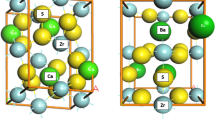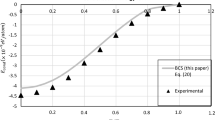Abstract
Starting from Yang's offdiagonal long-range order concept and the macroscopic occupation condition for the second order density matrix as the basis for condensation phenomena we develop the notion that the extremal wave function (EWF), which is related to these conditions, leads to superconductivity in monatomic systems. We prove that the BCS model and the version where it is projected onto a fixed number of particles posesses EWF properties, differs negligibly from the EWF, and conserves offdiagonal ong-range order. The condition for the EWF to be energetically favored is the presence of macroscopic degenerate one-electron energy levels in the system, partial occupation of this degenerate region, and also an effective attraction among the electrons. Considerations are advanced indicating that these conditions are satisfied in the high temperature superconducting metal oxide ceramics, due to the presence of macroscopically degenerate diffuse orbitals distributed among the O− ions in the CuO2 layers, and with the effective screening of these layers by the metal-like La, Ba, Y, or O layers.
Similar content being viewed by others
Literature cited
J. Bardeen, L. M. Cooper, and J. R. Schrieffer, Phys. Rev.,108, No. 4, 1175–1203, 1957.
C. N. Yang, Rev. Mod. Phys.,34, No. 3, 694–704 (1962).
A. J. Coleman, Rev. Mod. Phys.,35, No. 3, 668–689 (1963).
F. Bloch, Phys. Rev.A137, No. 3, 787–795 (1963).
A. J. Coleman and S. Pruski, Can. J. Phys.,43, No. 7, 2142–2160 (1965).
J. G. Benorz and K. A. Muller, Z. Phys.,B64, No. 2, 189–143 (1986).
A. S. Aleksandrov, Zh. Fiz. Khim.,57, No. 2, 273–284 (1983).
W. Little, Usp. Fiz. Nauk,86, No. 2, 315–370 (1965).
B. Shirakawa and S. Ikeda, Polymer,2, No. 2, 231–244 (1971).
R. L. Green, G. B. Street, L. I. Suter, Phys. Rev. Lett.,34, No. 10, 577–579 (1975).
S. Barisic and A. Bjelis, Theoretical Aspects of Band Structure, B. Kamimura (ed.) Reidel Publishers, Dordrecht (1985), pp. 49–122.
D. A. Kirzhnits, Usp. Fiz. Nauk;125, No. 1, 169–194 (1978).
S. A. Moskalenko, Fiz. Tverd. Tela,4, No. 1, 276–284 (1962).
D. Allender, J. Bray, and J. Bardeen, Phys. Rev.,B7, No. 3, 1020–1031 (1973).
W. Kohn and D. Sherrington, Revs. Mod. Phys.,42, No. 1, 1–11 (1970).
A. V. Luzanov and M. H. Mestechkin, Teor. Mat. Fiz.,48, No. 2, 266–275 (1981).
V. L. Ginzburg, Usp. Fiz. Nauk;95, No. 1, 91–110 (1968).
J. A. Coleman, A General Theory for Superconduction Phenomena in Physics; Queens University Preprint, Kingston (1975).
B. T. Matthias, Superconductivity; Proc. 1st Advanced Study Summer Institute, Vol. 1. Gordon and Breach Publishers, New York, (1968) pp. 225–293.
V. Z. Kresin, Zh. Struk. Khim.,12, No. 4, 745–759 (1971).
Ph. Durand, Reduced Density Matrices with Applications to Physical and Chemical Systems, A. J. Coleman and R. M. Erdahl (eds.), Queens University, Kingston (1968), pp. 283–299.
A. V. Luzanov and Y. V. Ivanov, Teor. Éksp. Khim.,26, No. 4, 385–396 (1990).
B. T. Matthias, Int. Quantum Chem.,S3, No. 2, 903–904 (1970).
M. E. Rensink, ANN. Phys.,44, No. 1, 105–111 (1967).
J. A. Coleman, Can. Phys.,42, No, 1, 226–239 (1964).
M. M. Mestechkin, Zh. Éksp. Teor. Fiz.,55, No. 7, 2003–2009 (1968).
Ch. B. Lushchik, Pis'ma Ch. Éksp. Teor. Fiz.,46, No. 3, 123–124 (1987).
M. M. Mestechkin, Theory of Atomic and Molecular Shells [in Russian], Vilnius (1971), pp. 346–351.
M. M. Mestechkin, Int. J. Quantum Chem.,13, No. 2, 469–481 (1978).
I. A. Misurkin and A. A. Ovchinnikov, Teor. Éksp. Khim.,3, No. 4, 431–436 (1967).
A. J. Coleman, J. Math. Phys.,6, No. 9, 1425–1431 (1965).
M. M. Mestechkin, Int. J. Quantum Chem.,13, No. 2, 675–672 (1967).
M. M. Mestechkin, Density Matrix Methods in the Theory of Molecules [in Russian], Naukova Dumka, Kiev (1977).
Biol. Inostr. Hauch.-Tekhn. TASS, No. 40, 41–42 (1987).
D. Douglas and L. Falicov, Superconductivity [in Russian] Nauka Moscow (1967), p. 30.
T. Ando, Rev. Mod. Phys.,35, No. 3, 690–702 (1963).
J. Nauman, Mathematical Foundations of Quantum Mechanics [in Russian], Nauka Moscow (1964).
P. D. Nigman, Usp. Fiz. Nauk,154, No. 4, 675–682 (1987).
G. M. Zhislin, Tr. Mosk Mat. O va,9, 81–120 (1960).
G. Delgado-Barrio and R. F. Pratt, Phys. Rev.,A12, No. 6, 2288–2297 (1975).
Encyclopedia of Chemistry, Vol. 2, [in Russian] I. L. Knunyantsa (ed.), Sov. Entsikl. (1990).
H. C. Longuet-Higgins, J. Chem. Phys.,18, No. 3, 265–274 (1970).
M. M. Mestechkin and G. E. Whyman, Molecular Physics,69, No. 4, 775–782 (1990).
D. L. Lifar', D. P. Moiseev, A. A. Motuz, et. al., Fiz. Nizki Temp.13, No. 8, 876–879 (1987).
V. N. Antonov, Vl. N. Antonov, V. G. Bar'yakhtar, et al., Physical Problems in High Temperature Superconductivity [in Russian], Naukova Dumka, Kiev (1990), pp. 93–106.
G. T. Klimko and M. M. Mestechkin, Int. J. Quantum Chem.,37, No. 4, 753–771 (1990).
M. Hammermesh, Group Theory and Its Applications to Physical Problems [in Russian], Mir Moscow, (19660.
C. C. J. Roothaan, Rev. Mod. Phys.,32, No. 2, 179–185 (1960).
I. E. Tamm, Fundamentals of the Theory of Electricity [in Russian], Nauka Moscow (1966).
Myung Hvan Whangbo and C. C. Torardi, Science,249, 1143–1151 (1990).
B. Fisher, Physica,C153–155, Part 2, 1349–1350 (1988).
Additional information
L. M. Litvinenko Institute for Physical-Organic Chemistry and the Chemistry of Coal, Academy of Science of the Ukrainian SSR, Donetsk. Translated from Teoreticheskaya i Éksperimental'naya Khimiya, Vol. 27, No. 4, pp. 395–413, July–August, 1991. Original article submitted February 25, 1991.
Rights and permissions
About this article
Cite this article
Mestechkin, M.M., Klimko, G.T. & Vaiman, G.E. Density matrix, superconductivity and molecular structure. Theor Exp Chem 27, 341–356 (1991). https://doi.org/10.1007/BF01372506
Issue Date:
DOI: https://doi.org/10.1007/BF01372506




